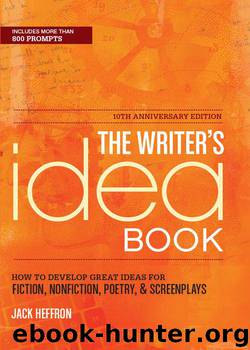The Writer's Idea Book by Jack Heffron

Author:Jack Heffron [Heffron, Jack]
Language: eng
Format: epub
Publisher: F+W Media, Inc.
Published: 2011-12-14T13:00:00+00:00
No thoughts or interpretations are included in this exchange. The writer simply observes and reports. This viewpoint is attractive for several reasons. The action of the story dictates and supplies a natural focus and gives immediacy to the narrative. Tension arises quickly as the reader tries to understand what is happening, why it’s happening, and what it means.
The difficulties of this viewpoint should be obvious. You must suggest the meaning of actions and details rather than explain them or have characters supply the meaning. If Jim begins wiping shot glasses when Alice arrives, you cannot explain that he always does this when he’s nervous. You must suggest his nervousness by describing how he wipes.
This viewpoint is rarely sustained for an entire story and is not used often anymore. It enjoyed a certain vogue in the late 1970s as part of the minimalist era. Raymond Carver, the godfather of minimalism, uses the objective viewpoint with amazing results in some of his early stories. Read his “Why Don’t You Dance?” for a great example of this viewpoint at work. The classic example of the objective approach is Hemingway’s story “Hills Like White Elephants,” in which a couple debates whether or not the woman should have an abortion. We enter neither character’s mind. In fact, they don’t even directly state what they’re discussing.
PROMPT: Describe a room using the objective viewpoint. Simply state the details. Don’t speculate on who lives there or on the person’s traits or tastes. But do select details that will show what the person is like by what is in her room.
Download
This site does not store any files on its server. We only index and link to content provided by other sites. Please contact the content providers to delete copyright contents if any and email us, we'll remove relevant links or contents immediately.
Asking the Right Questions: A Guide to Critical Thinking by M. Neil Browne & Stuart M. Keeley(5664)
Autoboyography by Christina Lauren(5186)
Eat That Frog! by Brian Tracy(4441)
Dialogue by Robert McKee(4328)
Sticky Fingers by Joe Hagan(4106)
Journeys Out of the Body by Robert Monroe(3573)
Annapurna by Maurice Herzog(3425)
Full Circle by Michael Palin(3393)
Schaum's Quick Guide to Writing Great Short Stories by Margaret Lucke(3323)
Elements of Style 2017 by Richard De A'Morelli(3310)
The Art of Dramatic Writing: Its Basis in the Creative Interpretation of Human Motives by Egri Lajos(3017)
Atlas Obscura by Joshua Foer(2902)
The Diviners by Libba Bray(2890)
Why I Write by George Orwell(2882)
In Patagonia by Bruce Chatwin(2878)
The Fight by Norman Mailer(2849)
The Mental Game of Writing: How to Overcome Obstacles, Stay Creative and Productive, and Free Your Mind for Success by James Scott Bell(2848)
Venice by Jan Morris(2527)
The Elements of Style by William Strunk and E. B. White(2443)
